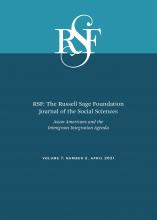Research Article
Open Access
From Narrative Scarcity to Research Plenitude for Asian Americans
Jennifer Lee, Karthick Ramakrishnan
RSF: The Russell Sage Foundation Journal of the Social Sciences April 2021, 7 (2) 1-20; DOI: https://doi.org/10.7758/RSF.2021.7.2.01
Jennifer Lee
aJulian Clarence Levi Professor of Social Sciences at Columbia University, United States
Karthick Ramakrishnan
bProfessor of public policy and political science at University of California, Riverside, United States

REFERENCES
- ↵
- Ahmad, Muneer I
- ↵
- Alba, Richard
- ↵
- ↵
- American Cancer Society
- ↵
- APIA Vote, National Asian American Survey, and Asian American Justice Center
- ↵
- ↵
- Byers, Bryan D., and
- James A. Jones
- ↵
- ↵
- Cho, John
- ↵
- Colbern, Allan, and
- Karthick Ramakrishnan
- ↵
- Colby, Sandra L., and
- Jennifer M. Ortman
- ↵
- Darling-Hammond, Sean,
- Eli K. Michaels,
- Amani M. Allen,
- David H. Chae,
- Marilyn D. Thomas,
- Thu T. Nguyen,
- Mahasin M. Mujahid, and
- Rucker C. Johnson
- ↵
- Dawson, Michael C
- ↵
- ↵
- ↵
- Espiritu, Yen Le
- ↵
- Fong, Jason
- ↵
- Gay, Claudine,
- Jennifer Hochschild, and
- Ariel White
- ↵
- Hajnal, Zoltan L., and
- Taeku Lee
- ↵
- Hein, Jeremy
- ↵
- Hochschild, Jennifer, and
- Vesla Weaver
- ↵
- ↵
- Ipsos
- ↵
- Kasinitz, Philip,
- Mary C. Waters,
- John H. Mollenkopf, and
- Jennifer Holdaway
- ↵
- Kennedy, Bud
- ↵
- ↵
- Lee, Erika
- ↵
- Lee, Jennifer, and
- Frank D. Bean
- ↵
- Lee, Jennifer, and
- Karthick Ramakrishnan
- ↵
- Lee, Jennifer, and
- Karthick Ramakrishnan
- ↵
- Lee, Jennifer,
- Karthick Ramakrishnan, and
- Janelle Wong
- ↵
- Lee, Jennifer, and
- Van C. Tran
- ↵
- Lee, Jennifer, and
- Monika Yadav
- ↵
- Lee, Jennifer, and
- Min Zhou
- ↵
- Lew-Williams, Beth
- ↵
- ↵
- Moore, Tina, and
- Daniel Cassady
- ↵
- Ngai, Mae N
- ↵
- Nguyen, Viet Thanh
- ↵
- NPR, Robert Wood Johnson Foundation, and Harvard T.H. Chan School of Public Health (NPR)
- ↵
- Okamoto, Dina
- ↵
- Omi, Michael, and
- Howard Winant
- ↵
- Pew Research Center
- ↵
- Pew Research Center
- ↵
- Portes, Alejandro, and
- Rubén G. Rumbaut
- ↵
- Ramakrishnan, Karthick
- ↵
- Ramakrishnan, Karthick, and
- Farah Z. Ahmad
- ↵
- Ramakrishnan, Karthick,
- Jennifer Lee,
- Taeku Lee, and
- Janelle Wong
- ↵
- Ramakrishnan, Karthick, and
- Taeku Lee
- ↵
- Ramakrishnan, Karthick, and
- Sono Shah
- ↵
- Ramakrishnan, Karthick, and
- Janelle Wong
- ↵
- ↵
- Rong, Xiaoqing
- ↵
- Roy, Arundhati
- ↵
- Shah, Sono, and
- Karthick Ramakrishnan
- ↵
- Stop AAPI Hate
- ↵
- ↵
- U.S. Census Bureau
- ↵
- U.S. Census Bureau
- ↵
- U.S. House of Representatives
- ↵
- U.S. Office of Management and Budget (OMB)
- ↵
- Wimmer, Andreas
- ↵
- Wong, Alia
- ↵
- Wong, Janelle
- ↵
- Wong, Janelle,
- Karthick Ramakrishnan,
- Taeku Lee, and
- Jane Junn
- ↵
- ↵
- Wu, Ellen
- ↵
- ↵
- Zhou, Min, and
- Carl Bankston III.
- ↵
- Zou, Linda X., and
- Sapna Cheryan
In this issue
From Narrative Scarcity to Research Plenitude for Asian Americans
Jennifer Lee, Karthick Ramakrishnan
RSF: The Russell Sage Foundation Journal of the Social Sciences Apr 2021, 7 (2) 1-20; DOI: 10.7758/RSF.2021.7.2.01
Jump to section
Related Articles
- No related articles found.
Cited By...
- No citing articles found.





